Jobs in Korea for Filipino 2025
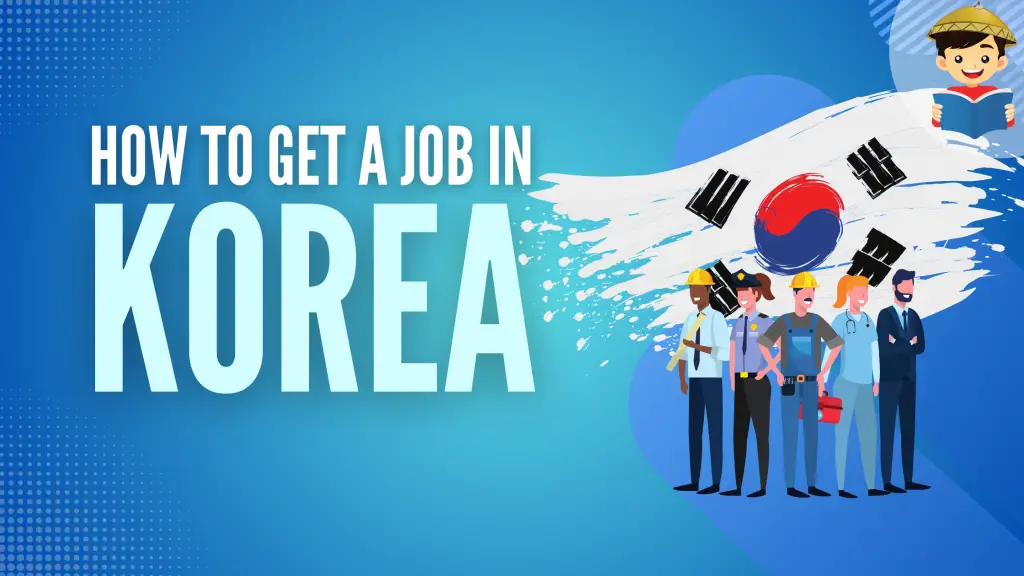
Due to the popularity of K-pop and K-dramas in the Philippines and globally, many Filipinos have been exposed to Korean culture. Some dream of traveling to South Korea, while some dream to live and work there. If you are one of those who wish to work in South Korea, then this article is for you.
South Korea struggles to respond to a labor shortage6 affecting its agricultural, construction, and manufacturing industries7. So, they are looking to rely on foreign workers to help with this problem.
In November 20218, South Korea has reallowed Employment Permit System (EPS) workers from the Philippines to enter the country. The following month, 251 Filipino workers9 entered South Korea through the system. In the coming months, more Filipinos will be deployed to South Korea and you might just become one of them.
Table of Contents
What Jobs in South Korea Are In-Demand for Filipinos?
1. Laborers
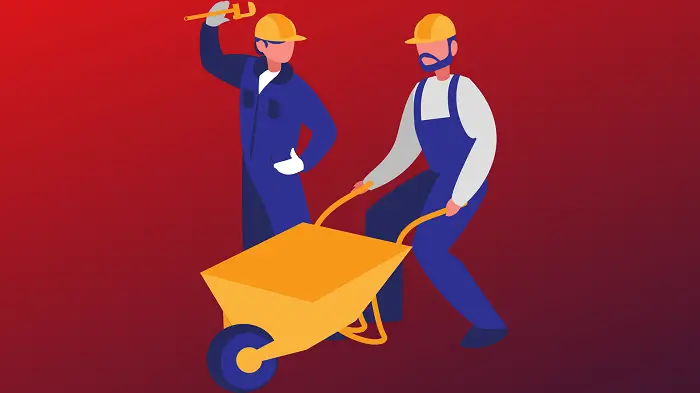
Overview: Laborers, particularly factory, construction, and farmworkers10, are in high demand in South Korea due to the labor shortage in the country. During the last EPS in 202011, around 900 Filipinos passed the exam to work in manufacturing for food, plastic, and other industries. However, their deployment was delayed due to the onset of COVID-19. As of December 202112, deployment has restarted, and a new EPS exam should be scheduled soon.
Average Salary13:
- Factory workers – 10,915.39 won/hr
- Construction workers – 15,565.14 won/hr
- Farm workers – 10,101.95 won/hr
Requirements:
- Must pass the EPS-TOPIK (Test of Proficiency in Korean)
- Experience is preferred and will boost the score in the EPS’ point-based system
2. Musicians

Overview: Though rare, jobs in South Korea are also available through POEA-accredited agencies. From 2020 to 2021, musicians were the most in demand based on the POEA database of job orders from South Korea.
Average Salary:
- Singers – 22,952.23 won/hr
- Keyboardists – 21,578.33 won/hr
Requirements:
- Please get in touch with a POEA-accredited agency for a complete list of requirements.
Job Variations: Singer, Vocalist, Keyboardist
3. Factory Supervisors and Managers

Overview: Partly due to the demand for workers in the manufacturing industries, there are also openings in the POEA database from 2021 that indicate the need for supervisors and managers in the same field. While there are no job orders yet for 2022, we may see more of them as travel restrictions relax in South Korea.
Average Salary: Factory supervisor – 26,348.62 won/hr
Requirements:
- Please get in touch with a POEA-accredited agency for a complete list of requirements.
4. Hotel and Restaurant Workers

Overview: According to data from Statistics Korea, there is a lack of labor in the in-person service industry, particularly the lodging and restaurant sector14. Korean workers appear to have shifted to the transportation and warehousing industries. While there is no specific immigration program yet for Filipinos who want to work in hospitality jobs in South Korea, you can see recent openings in job platforms, particularly for international hotel chains.
Average Salary:
- Hotel receptionist – 9,461.03 won/hr
- Waiter/waitress 9,159.99 won/hr
Requirements:
- Please check online job platforms for the specific requirements of the particular job.
5. Engineers

Overview: South Korea is also experiencing engineering labor shortages, particularly in electronics15 and shipbuilding industries16. Though rare, a few jobs are available for engineers through POEA-accredited agencies, as indicated by the POEA database. You’ll find the most available jobs posted on online job platforms instead.
Average Salary:
- Electronic engineer – 25,594.92 won/hr
- Marine engineer – 27,606.23 won/hr
Requirements:
- Please check with a POEA-accredited agency or an online job platform for the specific requirements of the particular job.
What Are the Different Ways for Filipinos To Get a Job in South Korea?
You would need to consider different pathways to South Korea depending on your desired job. Here are the primary methods you can work in South Korea:
1. Employment Permit System (EPS)
EPS was introduced in 200417 to address the growing number of issues that migrant workers were facing in South Korea, such as employer abuse, illegal recruitment, and scams. In the Philippines, South Korea’s Ministry of Employment and Labor partnered with local agencies such as DOLE and POEA to implement this system successfully.
EPS sends the highest number of Filipinos to work in Korea. They screen applicants through tests in language, skills, and competency. Exam passers usually work as agricultural, manufacturing, and construction laborers.
2. POEA-Accredited Agencies
The Philippine Overseas Employment Administration, or POEA (now the Department of Migrant Workers or DMW), accredits agencies and foreign employers to safeguard OFWs from illegal labor practices. Through these accredited agencies, you can be assured that the job you get will comply with the minimum employment standards set by POEA.
POEA-accredited agencies are usually the prime way to get a job in other countries such as Japan, Canada, or New Zealand. However, that is not the case in South Korea. From 2020 to 2021, a few job orders were posted in the POEA database. However, as labor shortages in South Korea increase, more opportunities may appear for Filipinos soon.
3. Online Job Boards
You can also browse professional social media channels such as LinkedIn to find a job in South Korea. If you know how to read Korean, you can go to Korean job boards such as JobKorea, Saramin, and PeoplenJob.
However, note that there is a ban on the direct hire of employees18 as per POEA rules. So, if you find an employer, you must help them get accredited by POEA/DMW and work with a POEA-accredited agency to process your application. It might be challenging to find an employer who would be willing to go through that process.
4. Korean Job Fairs
In 2019, the Korean Embassy in the Philippines launched a Korea-Philippines Job Fair19. However, succeeding events were not held likely due to the pandemic. As the effect of the pandemic wanes, make sure to follow the social media pages of the Korean Embassy to keep yourself updated for the next job fair.
5. Intra-Company Transfer
If you are working in a Philippine branch of a multinational company that also has an office in South Korea, then you might have the option to transfer there with your company’s support. If you have worked for at least one year in your company, then the Intra-Company Transfer D-7-1 visa might be available. Of course, you must coordinate with your company’s HR department first to make this happen.
How To Get a Job in South Korea: 5 Steps
1. Choose a Pathway That Is Most Applicable to You
Your job in South Korea differs greatly depending on your chosen pathway. Therefore, it’s crucial that you study them carefully so that you know exactly what you are in for.
a. Through EPS
To get a job through EPS, you need to earn enough points. EPS uses a point-based system to select Filipino applicants based on the results of their TOPIK (Test of Proficiency in Korean), skills, and competency exams. These exams are held on an announcement basis, meaning there is no fixed schedule. You must keep updated through Korea’s EPS website or POEA (now DMW) announcements.
These announcements will usually outline the registration procedure and any additional requirements they might have. Here are the common requirements20:
- Between 18 to 38 years old (not exceeding 38 years old on the test date)
- Accomplished registration form issued by POEA/DMW
- Pre-employment Medical Exam (PEME) result from a DOH-accredited medical clinic
- Original and photocopy of school diploma
- Original and photocopy of a valid passport
- Original and photocopy of valid NBI clearance
- Valid Korean Language Culture (KLC) training certificate. Be careful when selecting a KLC training center. POEA warned language center scams that guarantee a “sure pass” on TOPIK.
- Experience is not required but will give bonus points
POEA also provided the breakdown of the costs21 of getting a job through EPS:
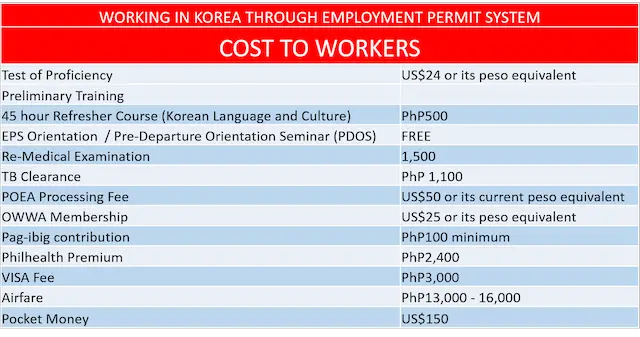
After the exam, you can check POEA/DMW for announcements on who passed. After that, you must follow any additional procedures while waiting for your deployment to South Korea.
b. Through POEA-Accredited Agencies
You can find jobs in POEA-accredited agencies by visiting the DMW database. Select the default search category, “Job Site,” from the drop-down box, input the name of the country (in this case, “South Korea” or “Korea”), and click the Search button to display the latest job orders available, specifically from South Korea.
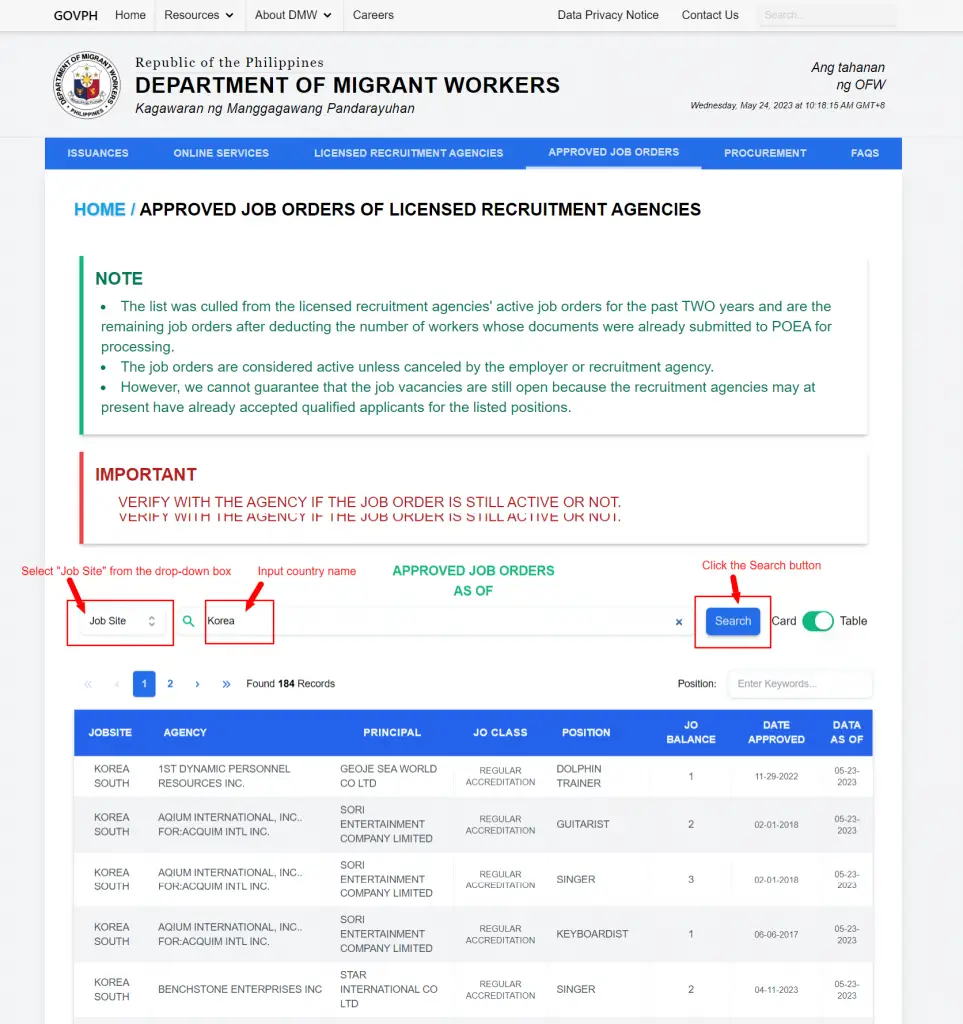
Using this list, you can create a list of jobs that you are interested in. Research each job carefully to know what to expect regarding responsibilities, salary, and other aspects.
After you are sure about the jobs you want, check if the agency still has a valid license using DMW’s agency database. You can type in their name on that web page, and a result like the one below will appear.
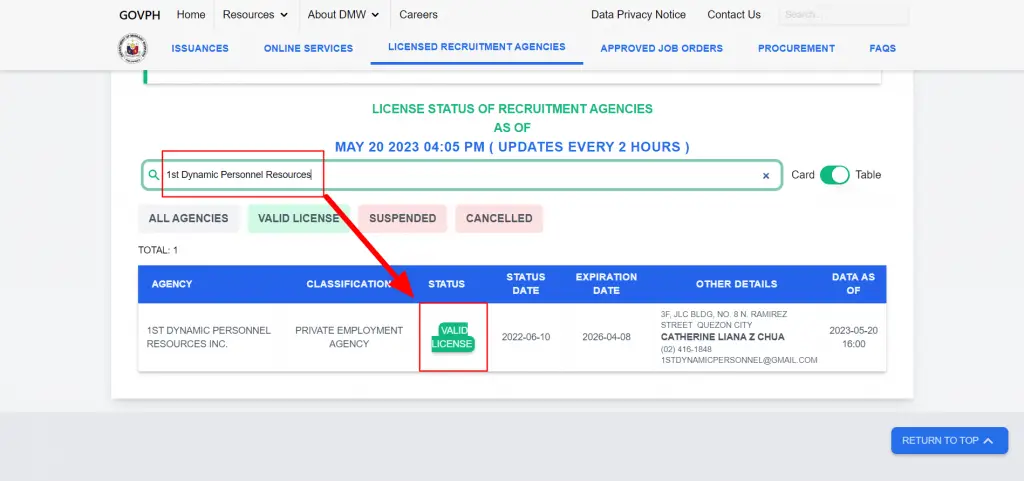
After that, you can contact them to inquire about the requirements they’ll need for the job you are eyeing. Next, prepare those requirements and update your resume. Once you are ready, submit your application to the POEA-accredited agency.
c. Through Other Channels
If you get a job through other channels, you must work with POEA’s Direct Hire Assistance Division (DHAD) to be cleared to work abroad. There is a ban on direct hiring, so you’ll need DHAD’s assistance to coordinate with your employer and a POEA-accredited agency to get clearance.
2. Put Your Best Foot Forward
Whatever pathway you choose, there are things you can do to increase your chances of getting hired. These include:
- Visit your potential employer’s company and social media pages. You can learn more about their history, industry, and, most importantly, what they value in an employee.
- Customize your resume and cover letter based on your knowledge of the company. This shows that you put in the effort.
- If you have Korean language skills, you may also send a resume in the South Korean resume format alongside your English resume.
- Prepare for the interview by listening to Koreans speaking in their native language and English. This can help you ace any question-and-answer portions during the interview. It would be best to prepare any questions about the job in advance.
3. Apply for a South Korean Work Visa
Once you get a formal job offer in writing, it’s time to apply for a Korean work visa. The type of visa you will apply for depends on how you got the job and what kind of job you got. You can check the Korean Visa Portal for a complete list but the most common visa categories for Filipinos are:
a. Non-Professional Visa
This is the visa category that most Filipinos choosing the EPS pathway will need to get22. This category is further divided into visas specific to the industry that the EPS worker will be assigned to.
- Manufacturing E-9-1 – assigned to workers in manufacturing
- Construction E-9-2 – assigned to workers in construction
- Agriculture E-9-3 – assigned to workers in agriculture or livestock
- Fishery E-9-4 – assigned to workers in fishery, sea farming, and sea salt farming
- Service E-9-5 – assigned to construction waste processing, cold storage, collection, and press publishing
b. Professional Visa
This is the visa category that people going through POEA-licensed agencies or other job platforms will likely need to get. The specific visa you’ll need depends on the profession. Here are some examples:
- Professor E-1 – for professionals engaged in education or research at educational institutions of higher than college level
- Foreign Language Instructor (General) E-2-1 – for people who will teach conversational language at a foreign language institute or educational institute of higher than elementary school
- Researcher E-3 – for people engaged in the research and development of advanced industrial technology or natural sciences
- Professional E-5 – for certified professionals such as engineers, lawyers, and accountants
- Artist E-6-1 – for people earning profits from music, fine arts, literature, acting, or other professional entertainment activities
c. Intra-Company Transfer
This is the visa category for people working locally at a company with a branch or headquarters in South Korea that they can transfer to.
- Intra-Company Transferee (Foreign Company) D-7-1. For people who have worked for at least one year at a foreign public institution, headquarters, or branch of a foreign company and are dispatched to the affiliates, subsidiary, or branch in the Republic of Korea in a field requiring expertise.
If you are unsure which work visa fits your situation, you can use the visa navigator on their website. Each visa will have different requirements but some common requirements23 include:
- Completed visa application form
- Original certificate of employment (You’ll need your employer’s help in getting this)
- Original personal bank certificate
- Bank statement
- Original passport and photocopy of the bio page
- One passport-size photo
- Photocopy of ITR or form 2316
- Copy of PRC or IBP card (if applicable)
4. Prepare for the Move to South Korea
After submitting your visa application, you can also start preparing for the move to South Korea. Here are some of the things you should do:
- Complete your Philippine OFW requirements. The three things you need from the Philippine government are the OEC (Overseas Employment Certificate), PEOS (Pre-Employment Orientation Seminar) certificate, and PDOS (Pre-Department Orientation Seminar) certificate. If you are a direct hire, you can check out this guide for the special process to get your OEC.
- Convert enough PHP to KRW (Korean won) or USD. The first thing you’ll need when you land is money for food or transportation. Find a way to access your money digitally if you can.
- Prepare your accommodations in advance. Finding a home on the fly might be challenging, especially if you don’t want to spend on an expensive hotel room. So, do your research and book a long-term home ahead of time.
- Learn how to read, write, and speak Korean. Learning the language will greatly improve your quality of life while staying in the country. You can also use apps to translate and learn Korean simultaneously, such as Naver Korean Dictionary, Google Translate, and Duolingo.
- Download local apps. You’ll need Kakaotalk, Korea’s most popular messaging app, if you want to communicate easily with your peers. It’s also recommended to download Subway Korea and Naver Maps so you won’t get lost.
- Pack clothes for extremely hot and cold weather. Weather in South Korea can be extremely erratic with cold winters reaching negative temperatures and hot summers reaching the high 30’s.
5. Make the Most Out of Life in South Korea
Once you’ve arrived in South Korea, there are still a number of things you need to prepare and do. These include the following:
- Get your Residence Card. Previously called the alien residence card, it was renamed to just the residence card in June 202024. You must get your residence card within 90 days of arrival25. You need to register online through HiKorea and then visit the immigration office in your district.
- Open a Bank Account in Korea. To open your account, you can approach tellers in big banks, such as KB Kookmin Bank or Shinhan Bank. Please note that you may need to prepare your passport, residence card, certificate of employment, and Korean phone number.
- Get a T-money card. This is a reloadable money card you can use to pay for transportation in Korea. It can be used for buses, subways, taxis, and more.
- Learn everything you can about the local laws and working culture. Did you know you can be fined for working elsewhere besides your designated workplace26? This also means you shouldn’t work for others even if your employer tells you to. Keep yourself informed so you can keep yourself protected.
- Reach out to Filipino communities and try to integrate with local culture. As a foreign worker living in another country, it’s up to you to find ways to socialize and enjoy yourself. It might not be easy at first, but you’ll be able to find a community where you can belong.
- If you want permanent residency in Korea, research the F-5 visa process. Getting an F-5 permanent residency visa is very different depending on what kind of work visa you have. You may also need to go through an F-2-7 or F-2-99 long-term residency visa first.
Why You Might Like Working in South Korea

Filipinos enamored with South Korea’s culture, economy, and opportunities would be glad to know that there are legitimate reasons for working in Korea. Here are some reasons why you might love working in South Korea:
1. Quality of Life
According to the OECD Better Life Index27, Korea ranks above average on jobs and earnings, housing, civic engagement, education, and skills, as well as personal security. If these are important, you might want to consider working there.
2. Competitive Salary & Company Benefits
South Korea increased the minimum wage in 2022 to 9,160 won28 or 73,280 won for an 8-hour workday. This rate will apply to all companies and employees, including foreigners. This translates to roughly PHP 3,155.96, or roughly six times the minimum wage in Manila. Aside from the higher salary, you also get benefits such as:
- Healthcare. All foreign workers are required to register under the National Health Insurance System (NHIS) in South Korea. Your employer can register and pay for you as part of your arrangement. The NHIS covers 50-80% of all healthcare costs.
- Free Lunch. You might be entitled to a free lunch or dinner depending on the company where you’ll be employed. A ‘Hweshik’ or a company gathering to eat and drink is also common.
3. Affordable Public Transportation
With a TMoney card29, you can enjoy convenient access to South Korea’s robust public transportation system. Rates are often cheap, with subway rides starting from 1,350 won, bus rides from 1,000 won, and taxi rides from 2,800 won.
4. World-Class Internet & Electronics
In 2020, South Korea ranked number 1 for having the fastest internet speed in the world30 at an average of 121 Mbps. Not only that, but it’s also the home to some of the top electronic brands in the world, including Samsung and LG.
5. High-Quality Education System
According to World Population Review31, South Korea ranked 19th in the world for its education system. If education is an important consideration for you or your family, it might be worth moving there.
6. Abundant Cultural, Food & Entertainment Activities
Not only is South Korea the home of K-pop and K-drama, but it also has a lot of historical and cultural landmarks dotted across the country. There are also many festivals yearly to enjoy unique food and shopping experiences.
Why You Might Not Like Working in South Korea

It’s important to clearly understand exactly what you are getting into when you work in South Korea. So, while there are a lot of benefits, there may also be some things you would not like when working there. These include:
1. High Cost of Living
Data from Numbeo32 suggests that the cost of living in South Korea is almost double the cost of living in the Philippines. While you can get a higher salary there, compute your actual take-home pay (salary less expenses and taxes). This way, you have an accurate picture of what you will earn there.
2. Law Does Not Mandate Sick Leaves
In South Korea, no law dictates that companies should provide paid sick leaves for their employees due to non-work-related illnesses. This may eat into your annual 15 paid leaves33 instead.
3. Work Culture Differences
Some differences in the work culture between the Philippines and South Korea may impact your decision to work there. These include:
- Long and Hectic Hours. The hard-driving work culture in South Korea was entrenched into their system due to the economic difficulties they encountered after the Korean War. Most companies still encourage long and hectic work hours as proof of commitment to the company. However, work-life balance34 reforms have started and you may find yourself in a company that encourages just that.
- ‘Hweshik’ and Drinking with Co-workers. While ‘hweshik’ or company gatherings with your peers may allow you to socialize and bond over drinks, it can get overwhelming due to excessive alcohol consumption. According to the Ministry of Health and Welfare, alcohol-related social costs amount to 20B USD annually35.
- Gender Gap. Despite improvements to the gender gap36 in South Korea, it still ranked 102nd in the World Economic Forum’s Gender Gap Report 202137. The Philippines ranks at number 17. This is because women in South Korea are under-represented in the labor force compared to men. There is also a stark lack of women in senior roles at only 15.6%.
- Hierarchal Company Structures. Traditionally, Korean companies have followed a Confucian hierarchical structure38. It emphasized the importance of juniors obeying their seniors and women obeying men—however, recent trends39 see the removal of these old hierarchies. But it might take time to overturn as this practice has been around since the 15th century.
4. Erratic Weather & Air Quality
The weather in South Korea can be very extreme. For example, in Seoul, the hottest recorded temperature in summer was 39.6°C40 while the coldest was -21.7°C41 in winter. The South Korean government is also struggling to combat the terrible air quality42 dominating its cities, making it one of the most polluted countries in the world.
5. Unpredictable Neighbor
Being next to North Korea, South Korea has a political climate that could become unstable. As recently as January 202243, missile testing from North Korea was reported by the South Korean military. For the people in South Korea, it might be business as usual. But for you, it could be a source of anxiety and confusion.
Filipinos in South Korea: A Brief Overview
Philippine and South Korean relations date back to the Korean War of 1950 when the Philippine Expeditionary Force to Korea (PEFTOK)44 was sent to help South Korea defend itself against North Korea. A total of 7,420 Filipino personnel served in Korea during the war and until they left in 1955.
Former Philippine President Fidel V. Ramos was one such Korean War veteran. In 1974, a monument was erected in Goyang City to remember the Philippine soldiers who helped in the war. Seventy years later45, ceremonies are still being held at the monument to celebrate their heroism.
As the Korean economy improved in the 1990s, it became an enticing destination for Filipino workers who wanted a better life. Significant migration happened in the late 1990s – mostly Filipinas marrying Korean men46. A notable counterflow also happened as well when more Koreans moved to the Philippines to do business or study, thus improving the exchange of culture in both countries.
By 200447, an estimated 41,000 Filipinos were already in Korea. However, many faced labor abuse, illegal recruitment, and exorbitant fees. Thus, the EPS (Employment Permit System) was established to address these issues. By 201248, 68,911 Filipinos were already working in South Korea under the EPS.
With the rising number of Filipinos in the country, Filipino organizations49, religious or social, also began to grow. It’s no surprise that a street for Filipino products50 was also established in Daehangno, Seoul, near a local Catholic church. They have many Filipino comforts that OFWs might otherwise have difficulty procuring.
As COVID-19 restrictions loosen, South Korea has again opened EPS to address its labor shortage. According to POLO, 21,546 Filipinos under the EPS worked in the manufacturing industry in 2021.
Tips and Warnings
1. Entry of Filipino workers with a valid Korean work visa is allowed51 provided that they are vaccinated and have a negative COVID-19 PCR certificate (tested within two days of departure). The accepted vaccines52 are the World Health Organization-approved vaccines: Pfizer, AstraZeneca, Janssen, Moderna, Covishield, Sinopharm, and Sinovac.
2. The Philippine Embassy in Seoul reissued a warning53 on scams and illegal recruitment for OFWs who want to work in Korea. Always research the agency and employer, especially if you did not go through EPS or a POEA-accredited agency. Here are some red flags to watch out for:
- Red Flag #1: They ask you to pay money to get hired.
- Red Flag #2: No online information about the agency or company exists.
- Red Flag #3: They did not provide a job description or requirements.
- Red Flag #4: They guarantee permanent residency.
3. Consider expenses and taxes when considering if it’s worth moving to South Korea. You might have a higher salary there, but you have to compute your actual take-home pay to properly compare it with what you are getting here in the Philippines.
- According to Numbeo54, a single person’s average monthly cost of living in South Korea is around Php 50,000 without rent. Meanwhile, they also estimate rent prices to be at least double the rate in the Philippines.
- For foreign workers in South Korea, an optional flat income tax rate of 19% is available until December 31, 202355. This special tax concession rate was recently extended from its original end date of December 31, 202156. So, remember that this tax rate might not be permanent, and you may be taxed using their normal progressive income tax rates of between 6% and 45% (depending on income) eventually.
Frequently Asked Questions
1. Is there a placement fee for getting a job in South Korea through POEA-accredited agencies?
Placement fees for jobs in South Korea through POEA-accredited agencies are currently on a case-to-case basis. It’s up to the agency if they would charge a placement fee or not. However, based on Section 51 of the POEA rules and regulations57, it is illegal to charge a placement fee of anything higher than one month’s salary.
2. Is there a placement fee for getting a job in South Korea through the EPS system?
There is no placement fee through the EPS system. However, unlike other countries where the employer shoulders some costs, jobs through the EPS system may require Filipinos to pay for expenses such as airfare and POEA processing fees.
3. Is it better to get a job in South Korea through POEA-accredited agencies or the EPS system?
The jobs available through the EPS system are mostly laborer jobs where you are expected to do physically demanding work in farms, factories, or other similar industries. Meanwhile, the jobs in the POEA-accredited agencies are more varied; however, the available jobs are much fewer. Ultimately, choosing the best method for your situation will be up to you.
4. How much is the minimum wage in South Korea?
South Korea recently increased the minimum wage for 2022 to 9,160 won per hour58 or 73,280 won for an 8-hour workday. This amounts to roughly six times the daily minimum wage in Manila. Hopefully, you’ll find a job that compensates you much more than the South Korean minimum wage.
5. Do I need a work visa for South Korea?
Yes, regardless of how you get a job in South Korea, a specific work visa is needed for your entry into the country. For example, Filipinos who passed the EPS system need the E-9 EPS work visa59. Meanwhile, an intra-company transfer D-7 visa60 is available for Filipinos working in a multinational company’s local Philippine branch who want to move to the South Korean branch.
6. Can I work in Korea without knowing the language?
Yes, but it depends on the job. Some jobs in South Korea value English language skills more than Korean language skills because the job involves primarily using non-Korean languages such as English. For example, some multinational companies require cross-country collaboration, meaning you talk more with foreigners than locals.
However, if you are planning to work in Korea through the EPS system, then it’s unavoidable. One of the requirements is to pass TOPIK (Test of Proficiency in Korean)61, which gauges your knowledge of the Korean language and culture.
Regardless, knowledge of the language will help improve your daily life there. So, it’s still important to learn it whenever you can.
7. Can Filipinos without experience find work in Korea?
Work experience requirements in South Korea depend on the job opening. In the EPS system, work experience may not be required; however, they increase your chances of getting hired. EPS follows a point-based system where you can get additional points if you can show evidence of your work experience for the competency test. So, having work experience will put you in a better position than the other applicants.
References
- Philippine Overseas Employment Administration (POEA). (2016). Revised POEA Rules and Regulations Governing the Recruitment and Employment of Land-based Overseas Filipino Workers [Ebook]. Retrieved from https://www.poea.gov.ph/laws&rules/files/Revised%20POEA%20Rules%20And%20Regulations.pdf
- Jun-tae, K. (2021). 2022 minimum wage set at 9,160 won, falling short of Moon’s campaign promise. Retrieved 24 February 2022, from http://www.koreaherald.com/view.php?ud=20210713000842
- Visa Services for the Employment Permit System (EPS) Workers. (2021). Retrieved 24 February 2022, from https://overseas.mofa.go.kr/ph-en/brd/m_3275/view.do?seq=760888&srchFr=&srchTo=&srchWord=&srchTp=&multi_itm_seq=0&itm_seq_1=0&itm_seq_2=0&company_cd=&company_nm=&page=1
- Intra-Company Transfer (D-7). (2013). Retrieved 24 February 2022, from https://overseas.mofa.go.kr/ch-en/brd/m_7996/view.do?seq=700070&srchFr=&srchTo=&srchWord=&srchTp=&multi_itm_seq=0&itm_seq_1=0&itm_seq_2=0&company_cd=&company_nm=
- Philippine Overseas Employment Administration (POEA). (2021). Announcement of Special EPS-TOPIK [Ebook]. Retrieved from https://poea.gov.ph/epstopik/files/210707_Announcement%20of%20Special%20EPS-TOPIK%20in%202021_Philippines.pdf
- Ji-hye, S. (2021). Korea struggles to respond to labor shortage amid pandemic. Retrieved 23 February 2022, from http://www.koreaherald.com/view.php?ud=20210328000132
- Kuhn, A. (2021). As Workforce Ages, South Korea Increasingly Depends On Migrant Labor. Retrieved 23 February 2022, from https://www.npr.org/2021/06/02/1001194446/as-workforce-ages-south-korea-increasingly-depends-on-migrant-labor
- Hicap, J. (2021). South Korea allows entry of EPS workers from the Philippines, 4 other countries. Retrieved 23 February 2022, from https://mb.com.ph/2021/11/05/south-korea-allows-entry-of-eps-workers-from-the-philippines-4-other-countries/
- 251 Filipino workers under ROK’s labor migration program enter S. Korea. (2021). Retrieved 23 February 2022, from https://dfa.gov.ph/dfa-news/news-from-our-foreign-service-postsupdate/29964-251-filipino-workers-under-rok-s-labor-migration-program-enter-s-korea
- Hee-rae, K., & Kim, M. (2021). S. Korea to ease migrant worker ban next month to tackle labor crunch. Retrieved 23 February 2022, from https://pulsenews.co.kr/view.php?sc=30800028&year=2021&no=1019942
- Passers List of EPS-TOPIK. (2021). Retrieved 23 February 2022, from https://www.poea.gov.ph/epstopik/files/STOPIK_Passers%20List_Philippines_211125.pdf
- Patinio, F. (2021). 158 OFWs enter SoKor via employment permit system. Retrieved 23 February 2022, from https://www.pna.gov.ph/articles/1162401
- Farmworker Poultry Salary South Korea. (2022). Retrieved 23 February 2022, from https://www.salaryexpert.com/salary/job/farmworker-poultry/south-korea
- Seul-gi, J. (2021). S. Korea faces a labor shortage of its own, but for different reasons than the US. Retrieved 23 February 2022, from https://english.hani.co.kr/arti/english_edition/e_national/1023628.html
- Jackson, J. (2017). Korea’s electronics industry suffering labor shortage: report. Retrieved 23 February 2022, from http://www.koreaherald.com/view.php?ud=20170815000205
- Min-hee, J. (2022). Korean Shipbuilders Facing Worker Shortage. Retrieved 23 February 2022, from http://www.businesskorea.co.kr/news/articleView.html?idxno=87749
- Open Working Group on Labour Migration & Recruitment. (2017). South Korea’s Employment Permit System A Successful Government-to-Government Model? Open Working Group on Labour Migration & Recruitment (Policy Brief #2) (p. 1). Retrieved from http://mfasia.org/migrantforumasia/wp-content/uploads/2017/01/2-Policy-Brief-South-Koreas-EPS-A-Successful-G2G-Model.pdf
- Philippine Overseas Employment Administration (POEA). (2018). POEA Memorandum Circular No. 08 Series of 2018 (Implementing Guidelines on the Registration of Direct-Hire Overseas Filipino Workers). Mandaluyong City: Philippine Overseas Employment Administration (POEA).
- Korean Embassy to launch 2019 Korea-Philippine Job Fair on June 1, 2019. (2019). Retrieved 23 February 2022, from https://www.gmanetwork.com/news/cbb/content/695764/korean-embassy-to-launch-2019-korea-philippine-job-fair-on-june-1-2019/story/
- Registration / Pre-Selection for the Korea Employment Permit System. (2007). Retrieved 23 February 2022, from http://mail.poea.gov.ph/ofw/korea_eps_klt.html
- Philippine Overseas Employment Administration (POEA). Working in Korea Through Employment Permit System (Cost to Workers) [Image]. Retrieved from https://www.poea.gov.ph/epstopik/files/cost_eps.png
- Visa Services for the Employment Permit System(EPS) Workers. (2021). Retrieved 24 February 2022, from https://overseas.mofa.go.kr/ph-en/brd/m_3275/view.do?seq=760888&srchFr=&srchTo=&srchWord=&srchTp=&multi_itm_seq=0&itm_seq_1=0&itm_seq_2=0&company_cd=&company_nm=&page=1
- Visa Requirements For Employees. (2019). Retrieved 24 February 2022, from https://overseas.mofa.go.kr/ph-en/brd/m_3277/view.do?seq=684566&page=1
- Min-ho, J. (2021). Korea to drop the term “alien” from ID cards for foreigners. Retrieved from https://www.koreatimes.co.kr/www/nation/2021/12/177_290506.html
- Alien Registration Card (ARC). (2019a). Retrieved from https://overseas.mofa.go.kr/sg-en/brd/m_2444/view.do?seq=721174&srchFr=&srchTo=&srchWord=&srchTp=&multi_itm_seq=0&itm_seq_1=0&itm_seq_2=0&company_cd=&company_nm=
- Employment and Status of Stay of Foreign Workers. (2021). Retrieved from https://www.easylaw.go.kr/CSM/SubCnpclsCmd.laf?csmSeq=1271&ccfNo=1&cciNo=1&cnpClsNo=1#:~:text=%2D%20The%20relevant%20foreign%20workers%20are,5%20of%20the%20Immigration%20Act).
- Korea. (2022). Retrieved 24 February 2022, from https://www.oecdbetterlifeindex.org/countries/korea/
- Chau, C. (2022). South Korea raises minimum wage by 5.1% in 2022. Retrieved 24 February 2022, from https://hrmasia.com/south-korea-raises-minimum-wage-by-5-1-in-2022/
- Transportation Cards. (2021). Retrieved 24 February 2022, from https://english.visitkorea.or.kr/enu/TRP/TP_ENG_8_1_1.jsp
- S. Korea boasts fastest internet connection, triples the global average. (2020). Retrieved 24 February 2022, from https://pulsenews.co.kr/view.php?year=2020&no=1106605
- Education Rankings by Country. (2022). Retrieved 24 February 2022, from https://worldpopulationreview.com/country-rankings/education-rankings-by-country
- Cost of Living in South Korea. (2022). Retrieved 24 February 2022, from https://www.numbeo.com/cost-of-living/country_result.jsp?country=South+Korea
- Yu, H., Ham, J., & Na, B. (2022). Employment and Employee Benefits in South Korea: Overview. Retrieved 24 February 2022, from https://uk.practicallaw.thomsonreuters.com/6-508-2342
- South Korea implements work-life balance reforms. (2019). Retrieved from https://globalnews.lockton.com/south-korea-implements-work-life-balance-reforms/
- Gooch, L., & Chao, S. (2016). The country with the world’s worst drink problem. Retrieved from https://www.aljazeera.com/features/2016/2/7/the-country-with-the-worlds-worst-drink-problem
- Hyunsoo, Y. (2021). Gender equality: Korea has come a long way, but there is more work to do. Retrieved from https://www.oecd.org/country/korea/thematic-focus/gender-equality-korea-has-come-a-long-way-but-there-is-more-work-to-do-8bb81613/
- (2021). Global Gender Gap Report 2021 Insight Report. Geneva, Switzerland: World Economic Forum. Retrieved from https://www3.weforum.org/docs/WEF_GGGR_2021.pdf
- Yarber, C. (2015). Confucian Hierarchy in Modern Day Korea. Retrieved from https://berkleycenter.georgetown.edu/posts/confucian-hierarchy-in-modern-day-korea/
- Ahrens, F. (2020). South Korea’s Corporate Hierarchies Are Breaking Down. Retrieved from https://foreignpolicy.com/2020/11/19/south-korea-corporate-hierarchy-breaking-down-chaebol/
- So-hyun, K. (2021). [Newsmaker] The worst of heat yet to come. Retrieved 24 February 2022, from https://www.koreaherald.com/view.php?ud=20210720000769
- So-hyun, K. (2021). Seoul has the coldest day in 35 years. Retrieved 24 February 2022, from http://www.koreaherald.com/view.php?ud=20210108000598
- Hu, E. (2017). Armed With NASA Data, South Korea Confronts Its Choking Smog. Retrieved 24 February 2022, from https://www.npr.org/sections/parallels/2017/10/10/552264719/armed-with-nasa-data-south-korea-confronts-its-choking-smog
- Seo, Y. (2022). North Korea fires two cruise missiles, South Korea says. Retrieved 24 February 2022, from https://edition.cnn.com/2022/01/25/asia/north-korea-cruise-missile-test-intl-hnk/index.html
- Office of the Philippine Defense and Armed Forces Attache. Retrieved 24 February 2022, from http://www.philembassy-seoul.com/dafa.asp
- Hicap, J. (2020). South Korea honors Filipino soldiers who fought in Korean War. Retrieved 24 February 2022, from https://mb.com.ph/2020/09/20/south-korea-honors-filipino-soldiers-who-fought-in-korean-war/
- International Organization for Migration (IOM). (2013). Country Migration Report – The Philippines [Ebook]. Makati City. Retrieved from https://www.iom.int/sites/g/files/tmzbdl486/files/migrated_files/Country/docs/CMReport-Philipines-2013.pdf
- Department of Foreign Affairs (DFA). (2004). Secretary Albert Assures Filipinos in Korea of Continued Government Protection for Their Interests. Retrieved from https://web.archive.org/web/20071011232332/http:/dfa.gov.ph/news/pr/pr2004/may/pr341.htm
- Seachon, K. (2015). Reconciling Labor Realities with Policy: The EPS and the Overseas Filipino Workers in South Korea. Retrieved 24 February 2022, from https://fsi.gov.ph/reconciling-labor-realities-with-policy-the-eps-and-the-overseas-filipino-workers-in-south-korea-vol-ii-issue-4-march-2015-2/
- List of Filipino Organizations. Retrieved 24 February 2022, from http://www.philembassy-seoul.com/filipino_community.asp
- Ravina, M. (2019). The Pinoy Street: Little Manila in Seoul, South Korea. Retrieved 24 February 2022, from https://www.habkorea.net/the-pinoy-street-little-manila-in-seoul-south-korea/
- COVID19 Updates – Immigration Regulations. (2022). Retrieved 24 February 2022, from https://www.koreanair.com/np/en/travel-update/covid19/travel-restriction/korea
- Philippine Overseas Employment Administration (POEA). (2021). Advisory No. 87: Outbound Overseas Filipino Workers (OFWs) Placed Under Priority Group A1 of the COVID-19 Immunization Program. Mandaluyong City: Philippine Overseas Employment Administration (POEA).
- Potential Filipino OFWs in Seoul Warned Off Illegal Recruitment in Embassy Webinar. (2021). Retrieved 24 February 2022, from https://dfa.gov.ph/dfa-news/news-from-our-foreign-service-postsupdate/28818-potential-filipino-ofws-in-seoul-warned-off-illegal-recruitment-in-embassy-webinar
- Cost of Living in South Korea. (2022). Retrieved from https://www.numbeo.com/cost-of-living/country_result.jsp?country=South+Korea
- Park, J.-H. (2022). Individual – Income determination (Republic of Korea). Retrieved from https://taxsummaries.pwc.com/republic-of-korea/individual/income-determination
- Jung, S.-H. (2021). South Korea – Provisions for Foreign Workers in Tax Bill. Retrieved from https://home.kpmg/xx/en/home/insights/2021/08/flash-alert-2021-222.html
- Philippine Overseas Employment Administration (POEA). (2016). Revised POEA Rules and Regulations Governing the Recruitment and Employment of Land-based Overseas Filipino Workers [Ebook]. Retrieved from https://www.poea.gov.ph/laws&rules/files/Revised%20POEA%20Rules%20And%20Regulations.pdf
- Jun-tae, K. (2021). 2022 minimum wage set at 9,160 won, falling short of Moon’s campaign promise. Retrieved 24 February 2022, from http://www.koreaherald.com/view.php?ud=20210713000842
- Visa Services for the Employment Permit System (EPS) Workers. (2021). Retrieved 24 February 2022, from https://overseas.mofa.go.kr/ph-en/brd/m_3275/view.do?seq=760888&srchFr=&srchTo=&srchWord=&srchTp=&multi_itm_seq=0&itm_seq_1=0&itm_seq_2=0&company_cd=&company_nm=&page=1
- Intra-Company Transfer (D-7). (2013). Retrieved 24 February 2022, from https://overseas.mofa.go.kr/ch-en/brd/m_7996/view.do?seq=700070&srchFr=&srchTo=&srchWord=&srchTp=&multi_itm_seq=0&itm_seq_1=0&itm_seq_2=0&company_cd=&company_nm=
- Philippine Overseas Employment Administration (POEA). (2021). Announcement of Special EPS-TOPIK [Ebook]. Retrieved from https://poea.gov.ph/epstopik/files/210707_Announcement%20of%20Special%20EPS-TOPIK%20in%202021_Philippines.pdf
Rod Michael Perez
Rod Michael Perez is a freelance writer with over 7 years of experience in writing long-form articles, ad copy, and SEO content for local and foreign clients. He is also an aspiring startup founder and believes that the Philippines could be the next hub for startup culture. He takes care of his dog, a poodle-Shih Tzu hybrid, in his spare time.
Copyright Notice
All materials contained on this site are protected by the Republic of the Philippines copyright law and may not be reproduced, distributed, transmitted, displayed, published, or broadcast without the prior written permission of filipiknow.net or in the case of third party materials, the owner of that content. You may not alter or remove any trademark, copyright, or other notice from copies of the content. Be warned that we have already reported and helped terminate several websites and YouTube channels for blatantly stealing our content. If you wish to use filipiknow.net content for commercial purposes, such as for content syndication, etc., please contact us at legal(at)filipiknow(dot)net
